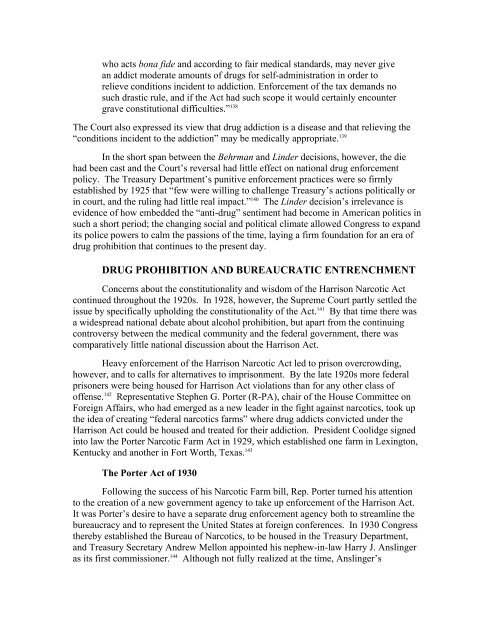Effective Drug Control: Toward A New Legal Framework
Effective Drug Control: Toward A New Legal Framework
Effective Drug Control: Toward A New Legal Framework
Create successful ePaper yourself
Turn your PDF publications into a flip-book with our unique Google optimized e-Paper software.
who acts bona fide and according to fair medical standards, may never give<br />
an addict moderate amounts of drugs for self-administration in order to<br />
relieve conditions incident to addiction. Enforcement of the tax demands no<br />
such drastic rule, and if the Act had such scope it would certainly encounter<br />
grave constitutional difficulties.” 138<br />
The Court also expressed its view that drug addiction is a disease and that relieving the<br />
“conditions incident to the addiction” may be medically appropriate. 139<br />
In the short span between the Behrman and Linder decisions, however, the die<br />
had been cast and the Court’s reversal had little effect on national drug enforcement<br />
policy. The Treasury Department’s punitive enforcement practices were so firmly<br />
established by 1925 that “few were willing to challenge Treasury’s actions politically or<br />
in court, and the ruling had little real impact.” 140 The Linder decision’s irrelevance is<br />
evidence of how embedded the “anti-drug” sentiment had become in American politics in<br />
such a short period; the changing social and political climate allowed Congress to expand<br />
its police powers to calm the passions of the time, laying a firm foundation for an era of<br />
drug prohibition that continues to the present day.<br />
DRUG PROHIBITION AND BUREAUCRATIC ENTRENCHMENT<br />
Concerns about the constitutionality and wisdom of the Harrison Narcotic Act<br />
continued throughout the 1920s. In 1928, however, the Supreme Court partly settled the<br />
issue by specifically upholding the constitutionality of the Act. 141 By that time there was<br />
a widespread national debate about alcohol prohibition, but apart from the continuing<br />
controversy between the medical community and the federal government, there was<br />
comparatively little national discussion about the Harrison Act.<br />
Heavy enforcement of the Harrison Narcotic Act led to prison overcrowding,<br />
however, and to calls for alternatives to imprisonment. By the late 1920s more federal<br />
prisoners were being housed for Harrison Act violations than for any other class of<br />
offense. 142 Representative Stephen G. Porter (R-PA), chair of the House Committee on<br />
Foreign Affairs, who had emerged as a new leader in the fight against narcotics, took up<br />
the idea of creating “federal narcotics farms” where drug addicts convicted under the<br />
Harrison Act could be housed and treated for their addiction. President Coolidge signed<br />
into law the Porter Narcotic Farm Act in 1929, which established one farm in Lexington,<br />
Kentucky and another in Fort Worth, Texas. 143<br />
The Porter Act of 1930<br />
Following the success of his Narcotic Farm bill, Rep. Porter turned his attention<br />
to the creation of a new government agency to take up enforcement of the Harrison Act.<br />
It was Porter’s desire to have a separate drug enforcement agency both to streamline the<br />
bureaucracy and to represent the United States at foreign conferences. In 1930 Congress<br />
thereby established the Bureau of Narcotics, to be housed in the Treasury Department,<br />
and Treasury Secretary Andrew Mellon appointed his nephew-in-law Harry J. Anslinger<br />
as its first commissioner. 144 Although not fully realized at the time, Anslinger’s
















